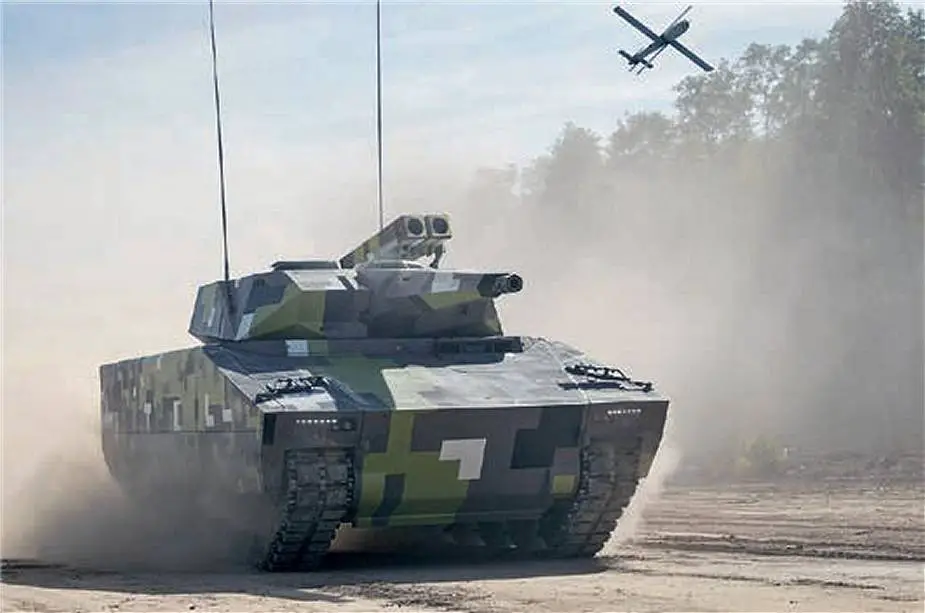German Lynx KF41 IFV could also integrate loitering munition as anti-tank weapon
According to a picture published on the Twitter account "PortalMilitarny.pl" on May 13, 2022, the loitering ammunition could be integrated into a combat armored vehicles as a new anti-tank weapon. A picture was released on the Internet showing the integration of HERO loitering munitions on the turret of the Rheinmetall Lynx KF41 tracked armored IFV (Infantry Fighting Vehicle).
Follow Army Recognition on Google News at this link

Artist rendering of German Rheinmetall Lynx KF41 armed with HERO loitering munition. (Picture source Twitter account PortalMilitarny.pl)
The Lynx KF41 is a new generation of a tracked armored vehicle developed and designed by the German Company Rheinmetall. The vehicle is one of the contenders for the Australian Defence Force's Land 400 Phase 3 program. It will replace the Australian Army's M113AS4 armored personnel carriers.
The first foreign customer for the Lynx KF41 is Hungary. On 17 August 2020, the government of Hungary and Rheinmetall Group signed a contract to start manufacturing the Lynx infantry fighting vehicle family in Hungary. Hungary has ordered 218 vehicles and the first vehicles will be built in Germany while 172 Lynx will be built in Hungary.
Other countries have also shown interest in acquiring the Lynx KF41 including Greece, the Czech Republic, Iraq, Slovakia, and the United States.
The Lynx KF41 is fitted with a Lance 2.0 turret which is offered in manned and unmanned variants. The main armament of the turret consists of one gas-operated MK30-2/ABM automatic cannon which can fire single rounds as well as bursts at a rate of 200 rounds a minute. It has high combat effectiveness against ground and aerial targets with a maximum firing range of 3,000 m. The second armament of the Lynx includes one 7.62mm coaxial machine gun.
The turret of the Lynx is modular and can be fitted with other weapon systems including anti-tank guided missiles such as the Israeli-made Spike LR missiles. The turret can be fitted with a variety of other subsystems according to mission requirements, including an electronic warfare capability, passive armor, Active Protection System (APS), and non-line-of-sight strike loitering munitions.
In January 2022, German company Rheinmetall announced the signature of a strategic partnership agreement with UVision on the Israeli company's Hero loitering munition aimed in the medium term at establishing a joint venture for the development and production of the munition. Citing information from the Israeli company Uvision, the loitering munition HERO can be easily integrated on Lynx or Fuch armored vehicles.
The latest information released by the Ukrainian armed forces showed that the loitering munitions could be very efficient weapons against tanks and armored vehicles. The HERO series of loitering munitions is an innovative electro-optical guided system capable of locating, tracking, and striking static and moving targets. The loitering munition could be the next generation of anti-tank weapons.
The Israeli company UVision has developed a wide range of loitering munition including the HERO-120 which was specially designed to conduct anti-tank missions. It carries a 4.5 kg warhead and can endure an extended flight time of 60 minutes. The loitering munition incorporates unique flight qualities, advanced airborne guidance and navigation systems, precision attack munitions, and C4 stations fully integrated with communication links. The sensors enable the military to independently locate and attack time-sensitive targets.
The HERO loitering munition is designed to carry out strikes in urban areas or remote locations with minimal collateral damage. The munition can reach a target at a maximum range of 40 km using LOS (Line Of Sight) guidance. The LOS is the line directly between the launcher and the target, which must be in view. If the target is moving the missile is constantly maneuvered to be in the line of sight as it changes, this results in the missile flying a curved path toward the target.


























